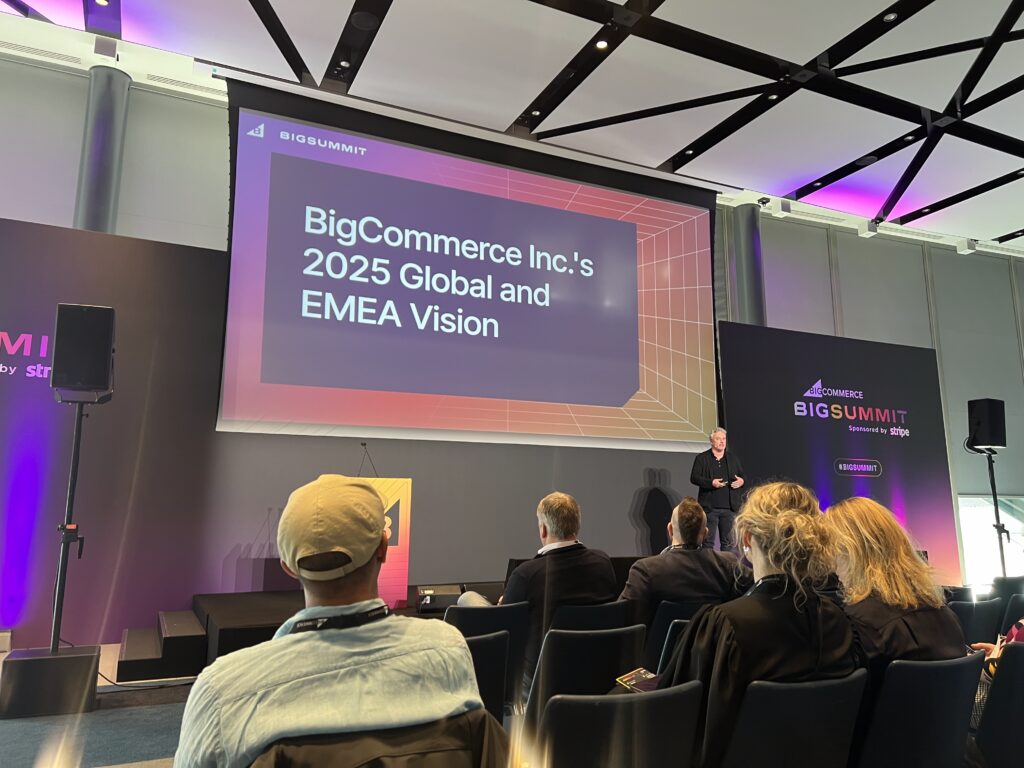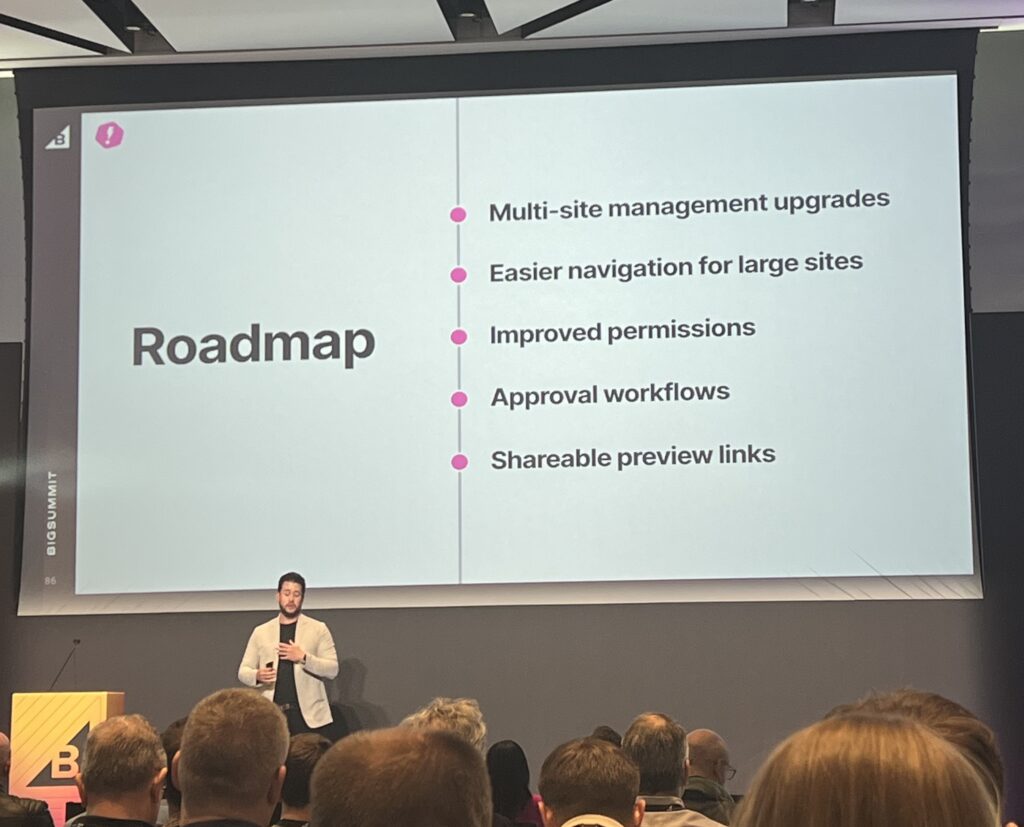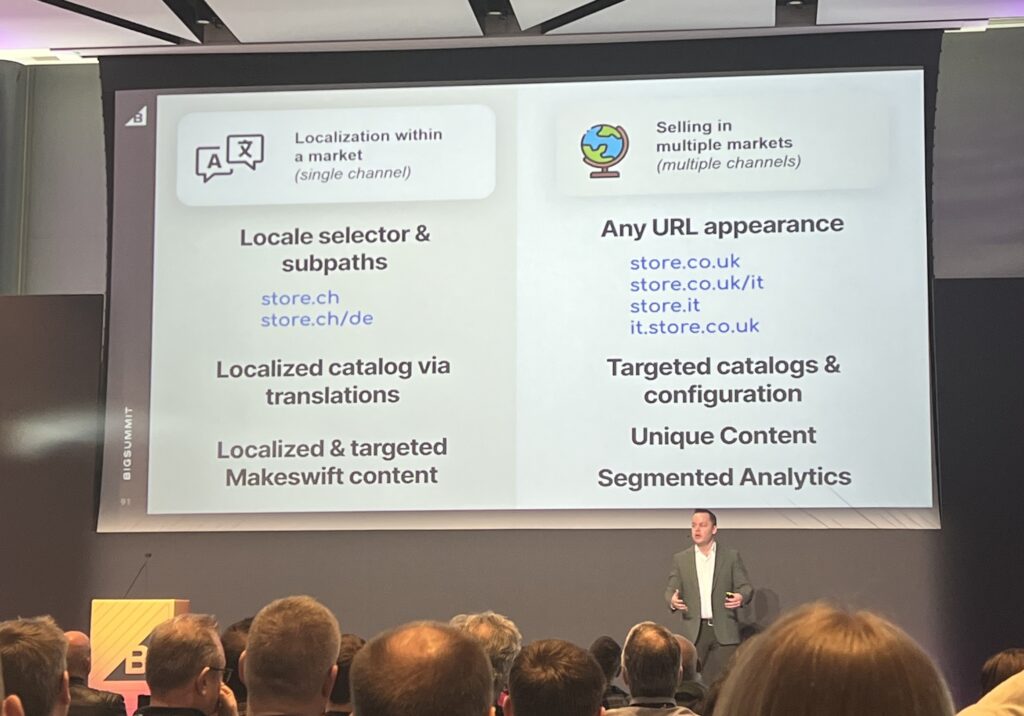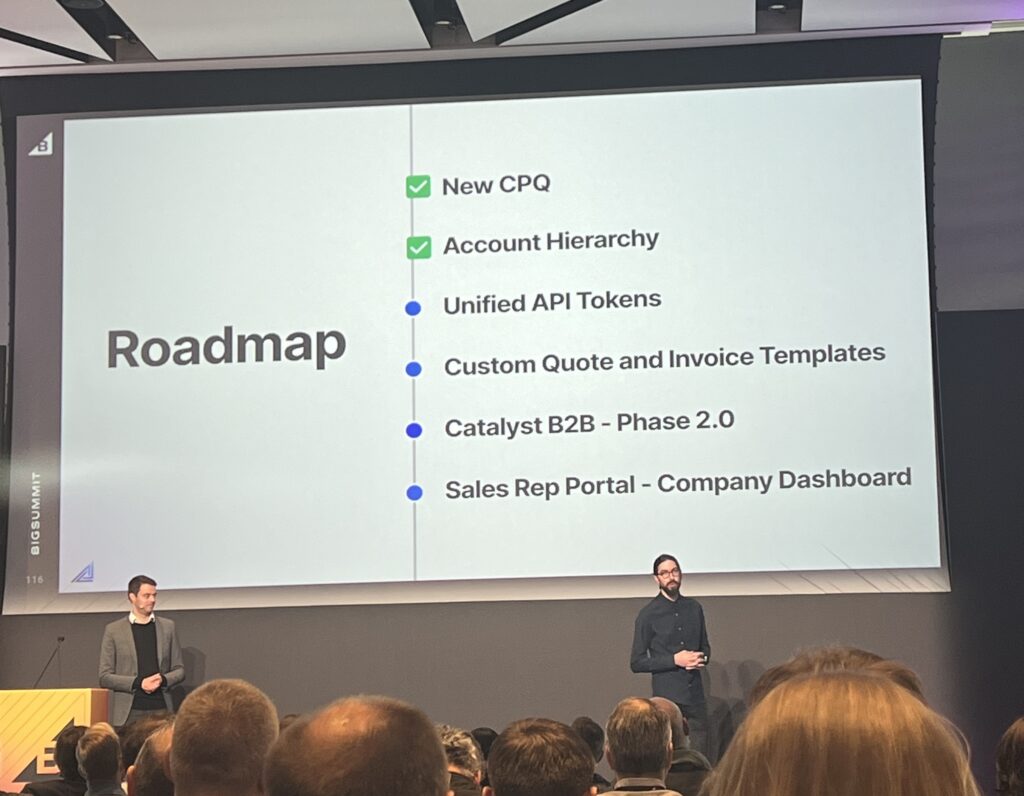BigCommerce hosted BigSummit EMEA on April 3rd at Tottenham Hotspur Stadium. There was keen interest in seeing how the company’s messaging had evolved – especially with this being the first event of the financial year and the first under new leadership, headed by CEO Travis Hess.
A Fresh Start for BigCommerce
The most notable change compared to last year? An overhaul of the leadership team. Today’s BigCommerce feels different: fresh perspectives, a changing culture, and “no sacred cows.”
From our conversations at the event, there was a sense of optimism about these changes.
Key messages from Travis Hess and his team included:
- BigCommerce remains one of the strongest independent ecommerce platforms — now larger than Magento was pre-Adobe, and larger than Demandware before Salesforce’s acquisition.
- The company has reorganised around three segments: B2B, B2C, and Small Business, with Feedonomics and Makeswift now integrated.
- Feedonomics will soon introduce a self-service plan, expanding access to more businesses.
- Makeswift will offer a standalone CMS product.
- A new parent brand may be introduced to unify BigCommerce, Feedonomics, and Makeswift.
While there were few new product announcements, the event reinforced BigCommerce’s strategic commitments and direction.
Setting the Stage: Travis Hess’ Introduction
Travis Hess opened by sharing his journey to BigCommerce and his vision for the company’s future. A key event theme was “curated composable“, positioning BigCommerce as:
- More composable than Shopify
- Less custom than Commercetools
This approach targets the upper midmarket: businesses too complex for out-of-the-box platforms but not looking to heavily customise technology.

Travis outlined three macro trends shaping ecommerce:
- Need for increased organisational agility
- Proliferation of selling channels
- The rise of AI and agentic commerce
BigCommerce is well positioned here, especially with Feedonomics simplifying multichannel management.
A Practical Approach to Shopify Comparisons
It wouldn’t be a BigCommerce event without mention of Shopify. However, the discussion this year was more practical, with less concern for competing directly.
BigCommerce acknowledged that it can’t outspend Shopify in R&D for the ecommerce mass market (the “80%”). Instead, its focus is clear: Serve businesses that Shopify cannot — particularly B2B and complex commerce that requires deeper customisation.
Notably, BigCommerce is pivoting away from feature lists toward solution-oriented messaging, aligning platform capabilities with real-world business needs.
BigCommerce’s Ideal Customer
Today, BigCommerce is especially well-suited to merchants who need to:
- Localise commerce and content across regions
- Orchestrate modern digital experiences integrating multiple partners
- Combine B2C and B2B selling strategies
These strengths make BigCommerce a compelling option for complex retailers moving beyond basic online stores.
A Rejuvenated BigCommerce
Since Travis Hess took the helm, BigCommerce has:
- Reduced headcount to streamline costs
- Reinvested in sales and rebuilt its go-to-market strategy around customer segments (B2B, B2C, Small Business)
- Aligned sales and marketing with SaaS best practices
- Refocused on high-value customers
Last year was about internal transformation. This year is about growth — expanding ARR through:
- Better serving existing customers
- Launching self-service options (Feedonomics, Makeswift)
- Continuing strong momentum in B2B (over 50% of new customers are B2B)
Product Updates: Solutions, Not Just Features
BigCommerce’s upcoming product packaging strategy, “The Next Big Thing,” wasn’t fully unveiled at the EMEA event – likely more to come at the US summit later this year.
A key new mantra: “The customer is the channel.” This reinforces the need for businesses not just to be present across channels but to optimise for each customer touchpoint within them.
Localisation Ready
Alan Pledger, founder of Makeswift, showed how localising content is a breeze in Makeswift, BigCommerce’s CMS product. Upcoming features for Makeswift include shareable preview links, more advanced workflow & permission management.

Nathan Booker, Senior Director of Product Management, then showed how the BigCommerce platform can handle multiple markets with localised catalog, search and checkout experience with market-specific shipping & payment options.
The best multi-market experience can be achieved through Catalyst, BigCommerce’s Next.JS reference implementation.

However, more is to come:
- Stencil, the BigCommerce-hosted storefront, will receive support for localisation.
- B2B edition will add support for localisation
- Catalog localisation capabilities will expand to include configuring some variants to be storefront specific
- Store credit will support multiple currencies.
Channel Management
If a key part of the messaging was the importance of bringing method to the madness of omnichannel, then Feedonomics is definitely a super power in wrangling its complexity.
Feedonomics is already considered a market-leading feed management tool, but it has plans to make it easier and accessible to even more people. It now has:
- The ability to sync inventory and product data between BigCommerce stores (and soon Shopify stores too). Monwell, a provider in online book stores for UK media, is shared as one of the case studies of a brand that has experienced the benefits of this approach.
- A new developer portal is now live.
Most notably, a self-service Feedonomics product is coming soon, opening it up to a broader market.
B2B as a strength
BigCommerce is increasingly leaning into B2B, with updates including:
- Multi-company hierarchy support so that more complex B2B organisations can be modelled. This comes with a new role-based permission system, to ensure that account management is as simple as possible.
- New Configure, Price, Quote (CPQ) capabilities
On the roadmap are:
- Unified API tokens to align B2B with the core BigCommerce API making it easier for developers
- Quote and invoice templates
- B2B support within Catalyst, the reference headless Next.JS implementation.
- A new Sales Rep portal to better enable sales teams.

The BigCommerce Core
Jordan Sim, VP of Product Management talked through some of the product updates to the core BigCommerce product.
These included:
- Support for multiple coupon codes applied to a single cart/checkout.
- Support for accelerated checkouts: Stripe Link and PayPal Fastlane (coming to the UK imminently)
- BigCommerce AI initiative has brought product recommendations. One BigCommerce customer, Pramworld, that migrated to the new solution saw revenue and conversion uplift while also saving in the region of $12,000/year. Pramworld have also adopted Category Merchandiser and Metafields Manager.
- Adding native support for backorders. So soon products can be configured to allow for overselling below a zero quantity and a negative inventory level will be tracked. Store owners will then be able to set a limit on the maximum amount that can be oversold.
- Checkout extensions will provide integration points for third parties to modify the BigCommerce checkout without customers needing to adopt a customised checkout.
Developer Experience
Georgia Hough, Senior Product Designer, took us through progress and plans for improving the developer experience for those working with the platform.
These included:
- Partnership with Gadget to lower the barrier to entry for new app developers when creating BigCommerce apps.
- We will also shortly see a new developer portal launch and a redesigned app marketplace.
- Over 100 apps are already Catalyst-compatible, with more coming weekly.
- Our apps that have already been verified as Catalyst compatible are Shift, Metafields Manager, Automated Categories, Category Merchandiser and File Explorer.
Closing Thoughts: A New Chapter for BigCommerce
While there were no groundbreaking announcements, the atmosphere at BigSummit EMEA felt different — more authentic, more confident.
BigCommerce has reset internally and is now outwardly focused again. We expect to see a more customer-centric, solution-focused BigCommerce emerge throughout 2025.
Their focus remains on:
- B2B commerce
- Complex commerce (e.g., omnichannel retailers)
- Global localisation
If the rumours are true and a new parent brand emerges, it could liberate Feedonomics to become even bigger — and perhaps eventually BigCommerce’s most strategic asset.
At Hypa, we’re excited to see these developments firsthand and continue building solutions that help BigCommerce merchants thrive in this new era.